
| LUBA Mboko Information and style comparison |
| I originally created this page to discuss a piece that was being offered to me. I have removed the image of that piece and have kept some of the example images on the page and I have just added some information on the uses of these pieces. |

| Female Bowl Bearer (Mboko) Luba, Democratic Republic of the Congo Wood, beads; H. 36.8 cm (14 1/2 in.) 19th century American Museum of Natural History, New York 90.0/2423ab |
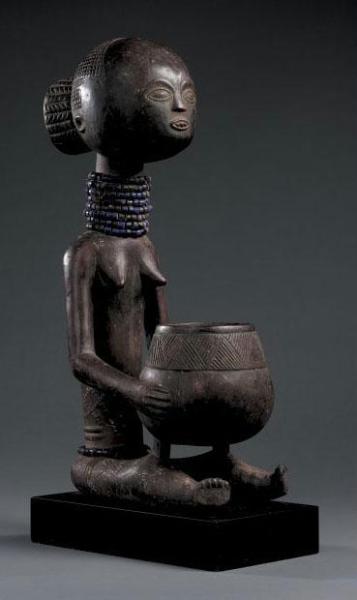
| Sotheby's - New York Arts of Africa, Oceania & The Americas Auction Date : May 17, 2002 Lot 13 : A RARE LUBA BOWL FIGURE Description seated, with attenuated legs held out to the front, holding a hollowed bowl on her lap, with an attenuated torso, beneath the spherical head with delicate features, the cross hatched backswept coiffure on a domed brow with chevron-decorated extension to the back; encrusted varied red-brown patina overall. Estimate:$ 25,000 - $ 35,000 Price Realized:$ 21,510 Provenance Pace Primitive and Ancient Art, New York Cf. Neyt (1993:26 and 37) and Roberts and Roberts (1996:cat.22) for related sculptures. Neyt (ibid.) emphasizes the uniqueness of the carving style in the work of the artist who carved this figure, 'Master of the Three Rivers" who produced only a few figures and whose work shows an "affiliation with the ateliers at Kabongo and Mwanze. |
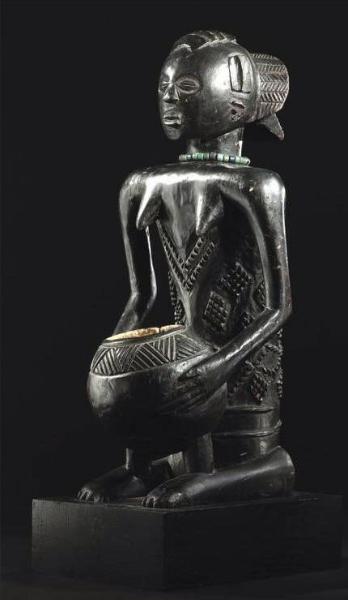
| Sotheby's - New York African, Oceanic and Pre-Columbian Art Auction Date : Nov 11, 2004 Lot 116 : A FINE LUBA SHANKANDI FEMALE BOWL BEARER Description seated on foreshortened legs, the salient torso with conical breasts and shelf-like shoulders pitched forward and leading to slender arms with hands resting on a spherical, hollowed bowl, the neck encircled by glass beads beneath the oval head with pursed mouth and coffee-bean eyes and wearing a multi-tiered coiffure; the whole decorated with incised and notched scarifications in bold chevron and diamond motifs; varied blackened patina. Dimensions height 19 1/4 in. 49cm Estimate:$ 30,000 - $ 50,000 Price Realized:$ 0 Provenance PROPERTY FROM THE ROSENBERG COLLECTION Notes Owned by chiefs and diviners, bowl figures were used in ceremonies to honor and remember the first mythical diviner. 'Rulers keep them at their doors filled with a sacred white chalk associated with purity, renewal and the spirit world. Usually, however, these figures are the prerogative of royal diviners...who use them as oracles, and as receptacles for their possessing spirit's wife' (Roberts and Roberts 1996: 70). The distinct iconographic qualities of the Rosenberg figure identifies her as part of the Mwanza sub-style of the Luba Shankadi, as outlined by de Maret, Dery and Murdoch (1973: 11). According to Neyt, in his discussion of a very closely related bowl, formerly in the Rubinstein collection, 'this piece shows a very specific type of coiffure with five lateral buns distributed in a fan-like manner on the head; however the fourth bun becomes almost semi-circular, overlapping the lowest one, a formal trait which differentiates this piece from the Kabongo style. [This figure] comes from the Mwanza region, in the southwestern part of the Upemba depression, on the left bank of the Upper [Congo] River. Other statues of this style have been collected in 1914, 1922 and 1929 by Macar, Rusmont, Dewit and Labrique: For related figures see one in the Iowa University Museum (Roy 1979: 179, figure 171); another in the National Museum of African Art, Washington, D.C.; a third in University of Witwatersrand, South Africa' (Sotheby's, New York, 1990, lot 431). For additional related figures see Fagg (1971: II-2) for one formerly in the Tara Collection; Roberts (ibid: 61); and Casa Coray (1968: no. 89) for one from the Coray collection. For further discussion of the Mwanza sub-style see Roberts (1998). |
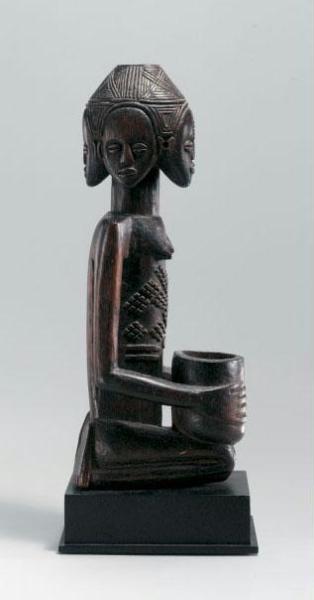
| Sotheby's - New York Arts of Africa, Oceania & The Americas Auction Date : May 17, 2002 Lot 143 : A FINE LUBA SHANKADI FEMALE FIGURE Description mboko, the kneeling figure with flat wedge-shaped feet to the back, beneath an elongated torso with raised cicatrices, the shelf-like shoulders with attenuated arms holding a hollowed vessel, the head with four faces, each with mouth and eyes of similar form, the front and back face with scarification at the forehead, and wearing a shared conical coiffure with linear striations; varied medium brown patina. Estimate:$ 20,000 - $ 30,000 Price Realized:$ 17,925 Provenance Collected by Maurice Matton, a Belgian government official in 1927 Mr. and Mrs. J.W. Gillon, London The Tara Trust, London Cecilia and Irwin Smiley Collection, New York |
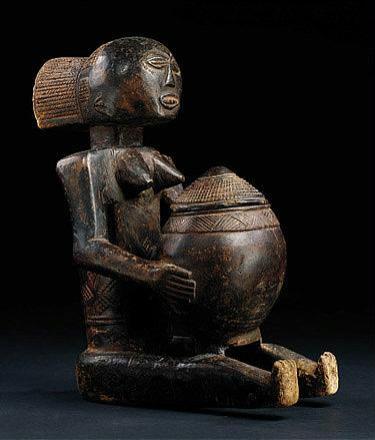
| Sotheby's - New York African and Oceanic Art Auction Date : Nov 16, 2001 Lot 145 : A Luba female figure with bowl Description A Luba female figure with bowl the figure seated with her legs stretched out to the front, and holding a hollowed bowl with conical lid on her lap, the slender body with broad shoulders and geometric raised scarification markings, the head with raised facial features and a cascading coiffure decorated with rows of chevron motif; fine and varied deep brown patina. height 16in. (40.6cm.) Cf. Roberts and Roberts (1996:71) and Neyt (1993:26-27) for closely related examples of this style. The extremely specific iconography of this figure places it in what Neyt calls the 'Three Rivers' style area. 'Bowl figures are owned by both chiefs and diviners to honor and remember the critical role played by the first mythical diviner, Mijibu wa Kalenga, in the founding of kingship... usually...these figures are the prerogative of royal diviners called 'Bilumbu' who used them as oracles. (Roberts and Roberts 1996: 70) Estimate:$ 8,000 - $ 10,000 Price Realized: $ 0 |
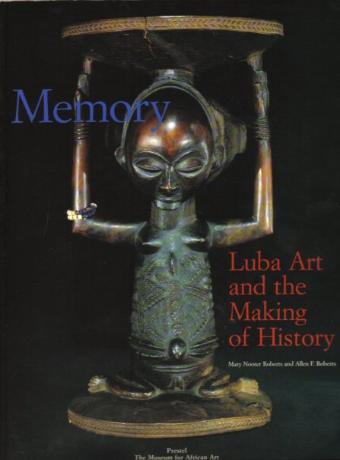
| Information below on Luba divination with Mboko figures and gords/baskets is from the book: Memory: Luba Art and the Making of History A fantastic reference book on the Luba |
| While Bilumbu diviners communicate with their possessing spirits by incantations, songs, and percussion, the spirits respond through visual codes, including the kinetic arrangement of items in a gourd or basket. For different purposes and occasions, Bwana Vidye among Luba, like some diviners among their Songye, Aruund (Lunda), Chokwe, Lovale, and Ovimbundu neighbors, use baskets and a variety of gourds that contain sundry natural and artificial objects (fig. 185). During consultation, a diviner shakes such a gourd and interprets the resulting configurations of items. Each object is mnemonically multireferential, or, as Turner would say, "polyvalent" (1970)—able to "hook up" conceptually to other objects, like atoms in molecules of meaning, or complex polymers of narrated memory. The juxtapositions of a basket's objects remind the diviners of certain general cultural rubrics and relationships through which they can classify the client's specific case. A metaphoric bridging occurs between general precepts and past precedents, on the one hand, and present-day woes on the other. In this way, sense and order can be perceived and created from the indecipherable simultaneity of lived experience (see V. Turner 1975:239). The contents of the gourd are a microcosm of memory, intention, and hope, then, and the product of the objects' reconfiguration is a pregnant hypothesis (Roberts 1995a:95). The items in the gourd are like the ideograms or beads of a lukasa or a staff. Here, though, the "bits" of meaning and experience are broken loose from the interpretive restraint of narrative plot. Though lukasas and staffs provide flexible systems of signification, they nonetheless present a static, fixed mode of narrative representation that can be experienced through their consolidated physical forms. The kinetic mnemonic devices used by Luba diviners, on the other hand, constitute a system whose parts are meaningfully aligned only through "random" casting, movement, and motion. Such a memory system allows for greater latitude of interpretation than a lukasa or other "sculpted narrative," a flexibility obviously necessary to cope with the vicissitudes of everyday life. And from an insider's viewpoint, of course, there is nothing random about the process or its results, for the objects' movements and juxtapositions are directed by spirits to reveal otherwise hidden concepts, relationships, and purposes. The prototypes for the objects and processes of this kind of divination are said to have been introduced by Mijibu wa Kalenga. A Bwana Vidye must be in trance to interpret a gourd's constellations of symbols; it is trance that allows the diviner to transcend this world so as to gain insight from the other. Most consultations are held inside diviners' homes. Once a Bwana Vidye has donned his or her apparel and set up the consultation area, clients are asked to enter the house, but only after taking off their shim, shoes, watches, hats, and belts. In other words, as many worldly signs are removed as is possible and polite. The client takes his or her place on a mat on the floor, while the diviner sits on a stool or bed, with the Kapamba (wife) and Kitobo (guide) to either side. The entire consultation is accompanied by songs for twins, sung by the diviner, his wife or wives, and his children, all of whom are usually present. The equipment for divination—calabashes, figures, horns, small baskets—is kept in a covered basket called a "kitumpo" (figs. 186-187) or, nowadays, in a metal trunk. Ordinarily, only the diviner may look into the basket or trunk to view the paraphernalia, and during consultations the diviner removes one object at a time for use, without ever exposing all of the trunk's contents. Among the most important objects in a Bilumbu kit is a sacred gourd containing natural and manufactured objects (fig. 188). This gourd, called "mboko" in the villages of Kinkondja and Malemba and "kileo" in the Kabongo Zone, is considered a source of well-being, wealth, good health, and truth (see Van Avermaet and Mbuya 1954:76-77). An mboko is filled with an array of objects, including tiny iron replicas of tools; composite magical bundles contained in antelope horns, cowrie shells, and the carapaces of dried beetles; one or more human teeth; caddis-fly cases; fruits, seeds, and twigs; bird beaks and claws; chalk; and a dozen or more miniature carved wooden human figures. This is the raw material with which the diviner diagnoses a problem. Facing the seated client, the Bwana Vidye shakes the mboko, then opens the lid to peer inside. Whichever objects or figures are standing or have come to the surface of the jumble of chalk-covered pieces are taken as revelatory signs. From these, the diviner begins to form "organizing images" and a hypothesis concerning the client's difficulty. The process is repeated again and again until a relatively clear understanding of the problem has been formulated. As one diviner explained the process, "the Bwana Vidye looks at the wooden figures, which give him information that he surrenders to the client. Understanding the configuration of figures in the gourd is possible only when the spirit has taken possession of the diviner. At that moment he can interpret the different aspects of these statues. Ordinary people, or Bilumbu not in possession, cannot determine their meaning or function." The symbols in the gourd are a multireferential, "open-ended analogical system" (Peek 1991:12), and only the diviner is capable of decoding and disclosing the secret meanings of their juxtapositions. The individual symbols are mnemonic, as are their larger configurations. But unlike lukasas, which uphold state and institutional ideology, and staffs, which validate personal claims to power, the mboko's messages are based on a set of moral premises intended to ensure health, justice, and social harmony. Turner, who has studied similar divination techniques among Zambian Ndembu to the southwest, suggests that "diviners are extraordinarily shrewd and practical. . . . The way they interpret their divinatory symbols reveals deep insight both into the structure of their own society and into human nature. . . . The symbols are mnemonics, shorthands, cyphers; . . . they serve as reminders to the diviner of certain general rubrics of culture within which he can classify the specific instance of behavior" (V. Turner 1975:209 and 239). The items in an mboko include both sculpted human figures, in postures such as coitus, and a wide variety of natural objects (fig. 189). Like the items in Ndembu divination baskets, these objects represent many things and each has many meanings: Some represent structural features in human life, aspects of the cultural landscape, principles of social organization and social groups and categories, and dominant customs regulating economic, sexual and social life. Others represent forces or dynamic entities, such as motives, wishes, desires, and feelings. Not infrequently the same symbol expresses both an established custom and a set of stereotyped conflicts and forms of competition that have developed around it. It is roughly true that the human figurines represent universal psychological types while many of the other objects refer specifically to Ndembu structure and culture (ibid.:214). The diviner's skill is determined, however, by "the way in which he adapts his general exegesis of the objects to the given circumstances" (ibid.:217). |
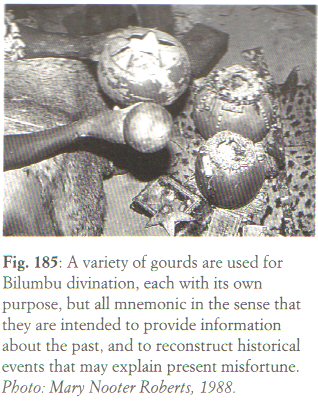
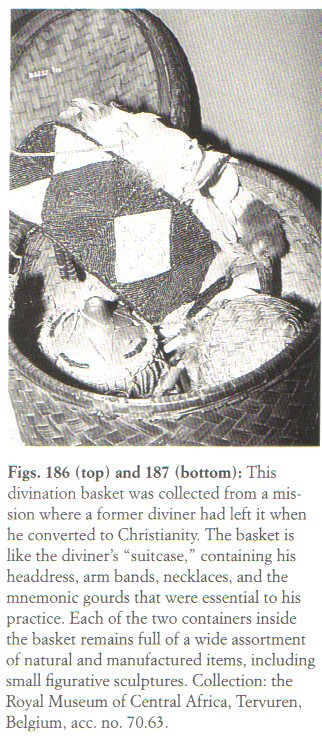
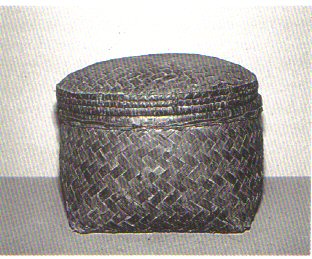
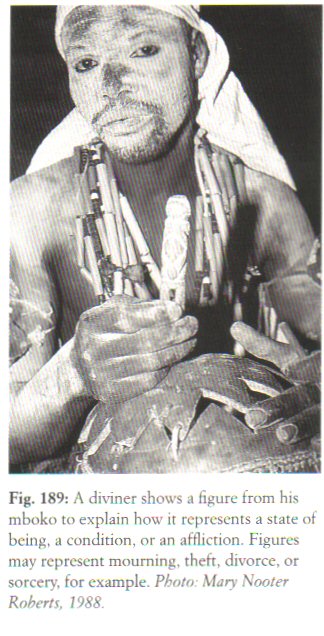
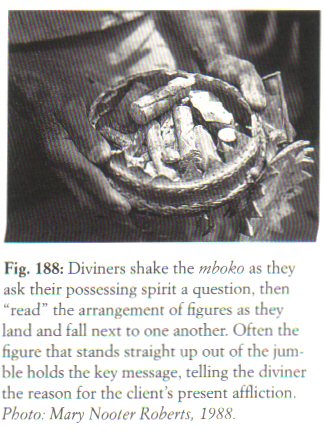
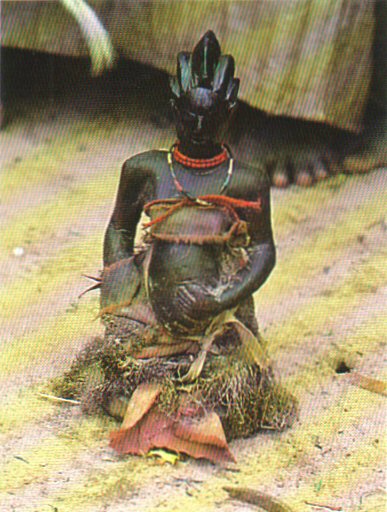
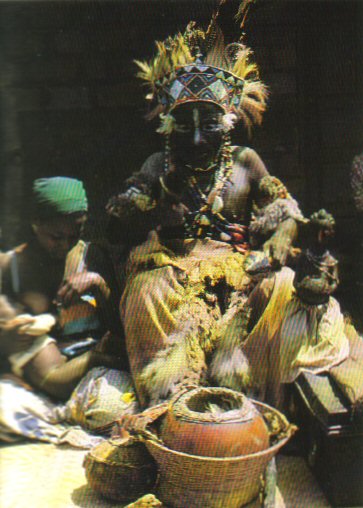
| Contemporary Luba diviners explain that the bowl figure (when female) represents the wife of the diviner's possessing spirit. Bowl figures also refer to the first Luba diviner, Mijibu wa Kalenga, who facilitated Kalala Ilunga's accession to the throne. Photos: Mary Nooter Roberts, 1988-89 |
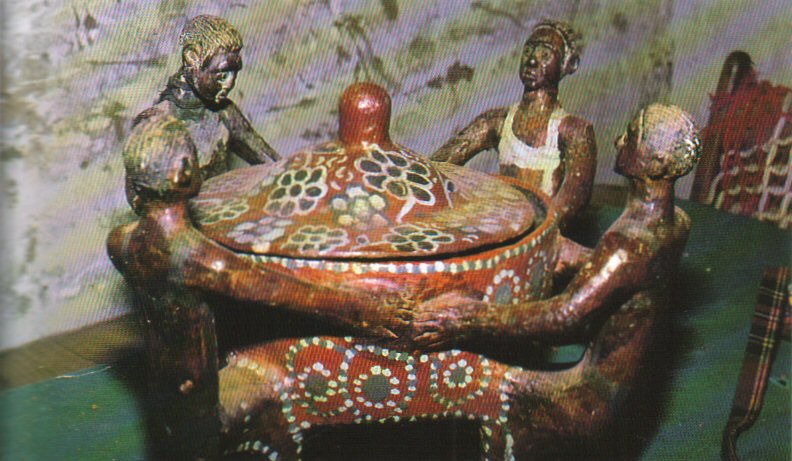
| Some contemporary chiefs own clay bowl figures with multiple human forms. Photo: Mary Nooter Roberts, 1988 |
| Rand African Art home page Return to the Educational Resources page |